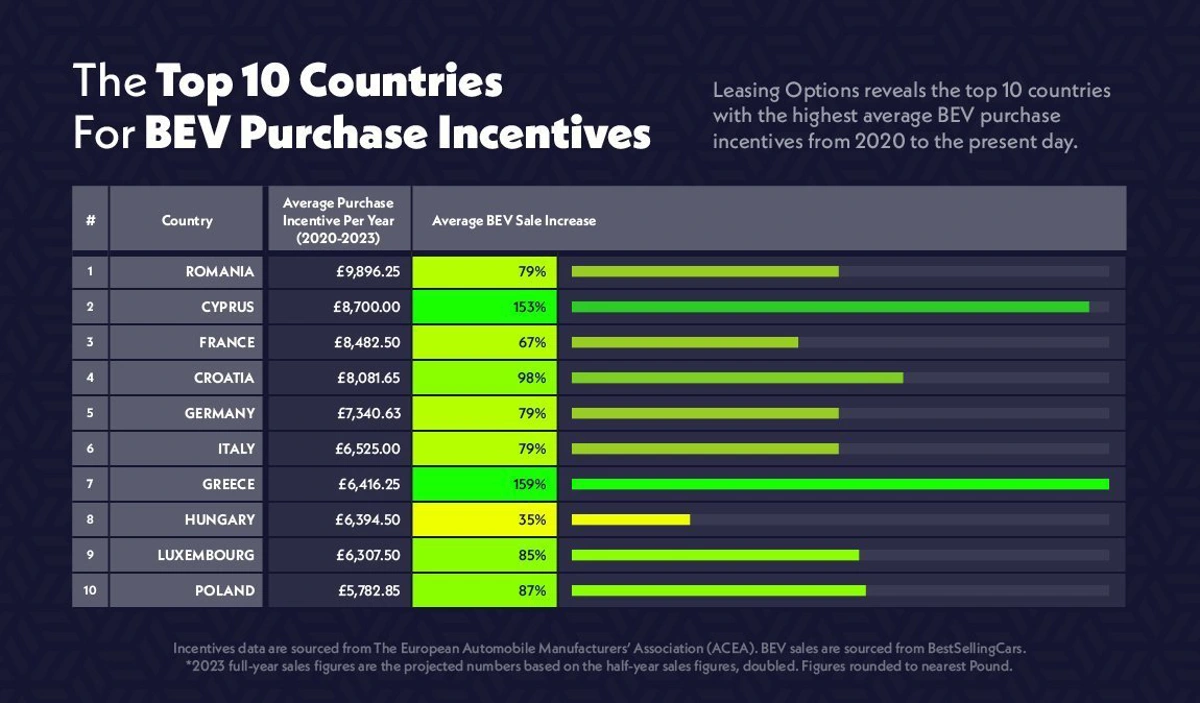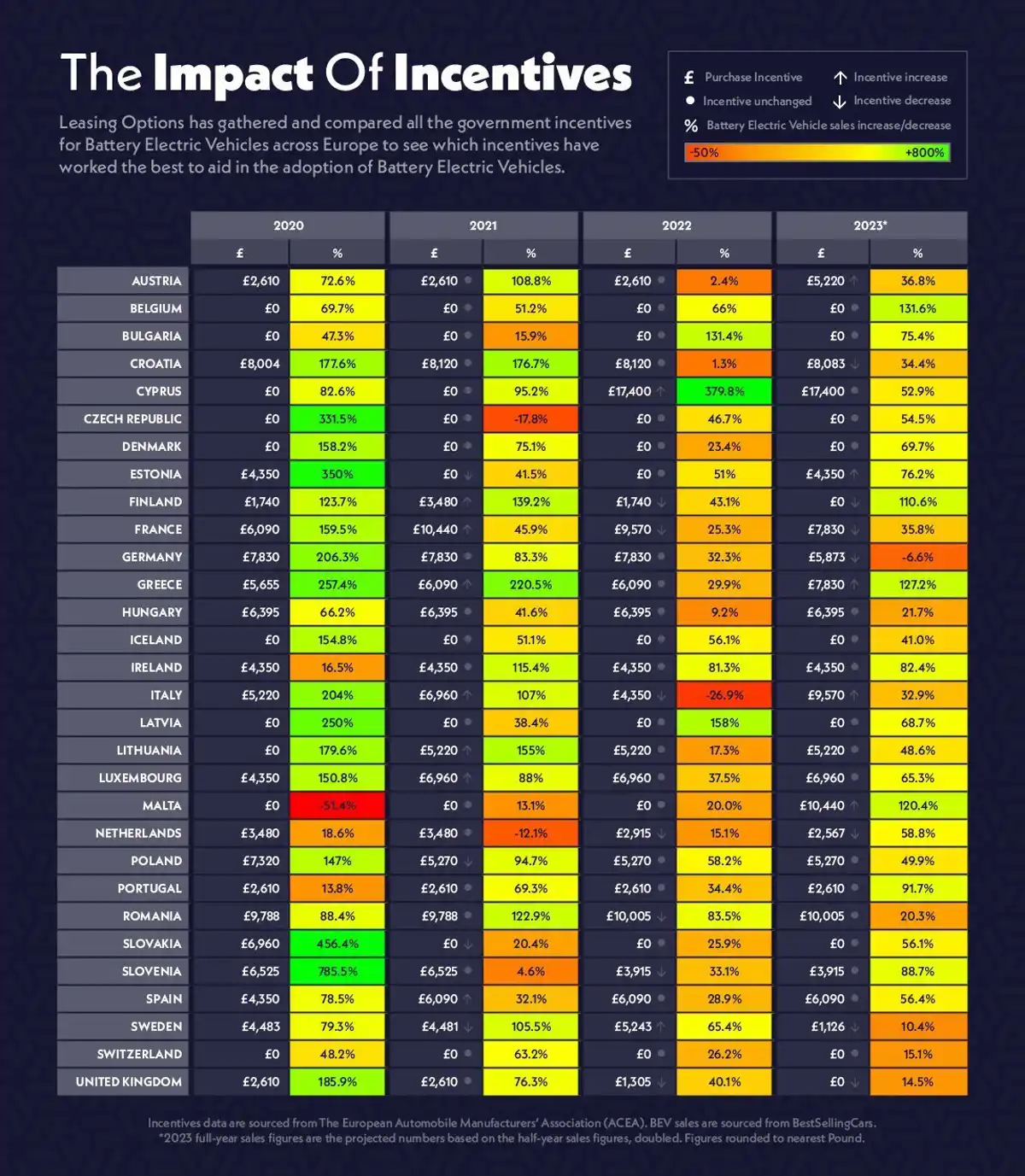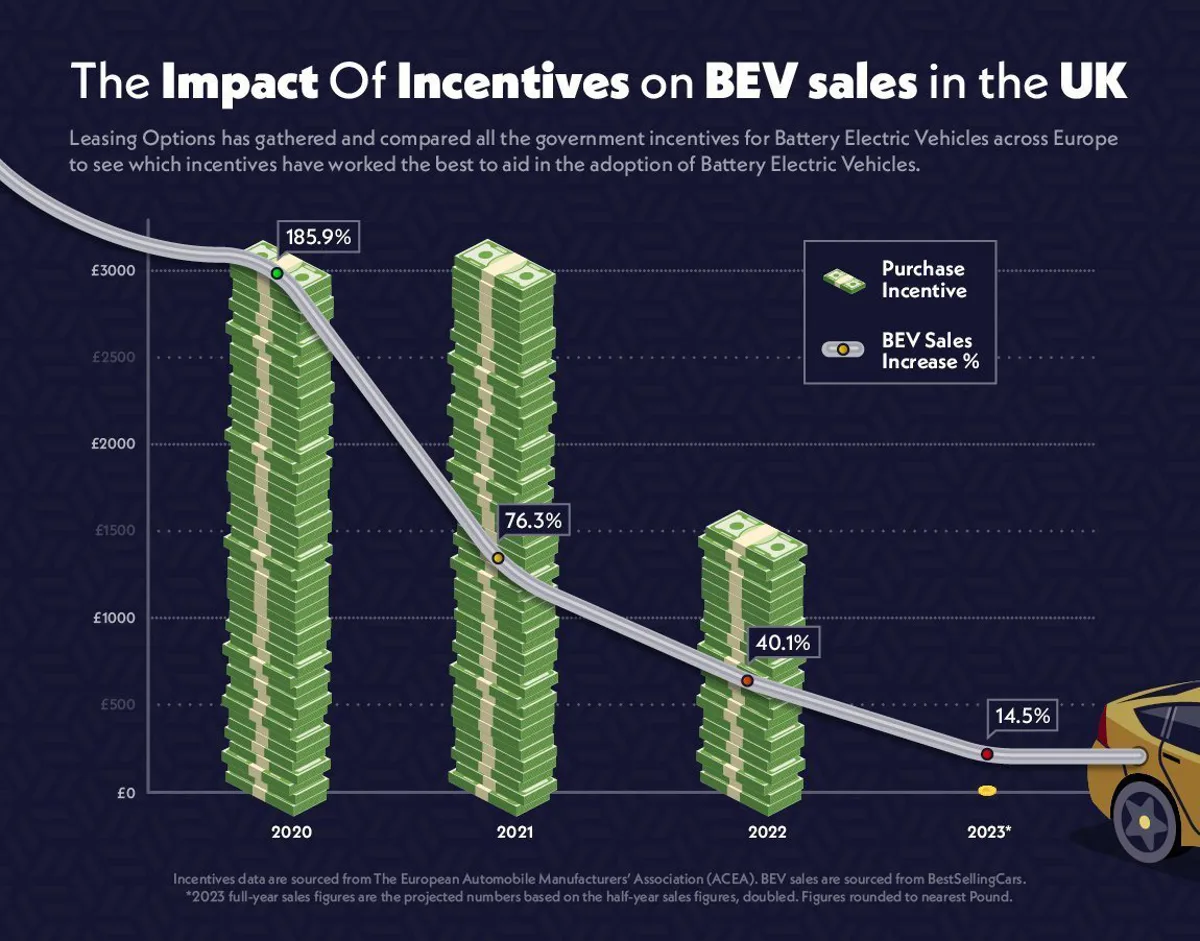The push to convert drivers to Battery Electric Cars (BEVs) is evident. For many years now, governments from across the globe have been releasing various incentives to entice drivers to make the move from internal combustion engine (ICE) vehicles over to the electric side. This includes things like purchase incentives, zero tax, grants for home EV charging wall boxes and many more.
In fact, the UK government has, as of the 25th of October 2023, passed a new law that will help encourage people to drive BEVs in another move to make charging an electric vehicle easier, quicker and more reliable. But the real question is, are these incentives working?
Is Europe Buying Into Purchase Incentives?
From 2020-2023, the governments in the European Union (EU) have granted drivers a total of €532,320.05/£465,337.02 in purchase incentive schemes, which is an average of €133,080.01/£116,334.25 per year. However, the EU’s adoption rate of BEVs is at its lowest since 2019, and countries in The European Free Trade Association (EFTA) are on course to sell fewer BEVs than the previous year — the first time since 2019.
Here at Leasing Options, we want to look at all the countries within the EU to see which government incentive schemes have worked the best when it comes to the resulting uptake in BEV registrations. We’ll also examine the impact of governments increasing and decreasing the incentives over the last few years to highlight the importance of the schemes across Europe.
Key Findings;
- Increasing incentives boosts BEV sales by 117.9%.
- Decreasing incentives causes an 83.9% sales drop-off.
- UK BEV sales slowed due to incentive removals, moving from an increase of 185.9% in 2020 to just 14.5% in 2023.
- Whenever a decrease is made to the purchase incentive of BEVs, on average, sales increase by only 34%.
- Romania has the highest BEV purchase incentive scheme in the EU.
Top 10 Countries For BEV Purchase Incentives
As part of our analysis, we can exclusively reveal the 10 countries with the highest average BEV purchase incentives from 2020 to the present day.

As you can see from the table above, Romania comes out on top as the number one country for providing the highest average BEV purchase incentives over the last four years, (2020-2023). Their government incentivises drivers by offering them a grant of €11,500/£10,041.83 (up from €11,250/£9,823.53) to purchase a new BEV and scrap their old car.
By the end of 2019, Romania recorded 1,506 BEV sales. By the end of 2023, it is projected that number will have increased by nearly 10 times, to 13,996 sales, an average increase of 79%.
The same can be said for Cyprus, which went from zero incentives until 2022, where they granted drivers up to a massive €20,000/£17,455.25 to buy a BEV (€80,000/£69,820.99 or under) and to scrap their old car in the process. This resulted in an equally impressive 379.8% increase in sales.
At the other end of the purchase incentives leaderboard are eight countries that have not offered any grants to their drivers over the last four years. Those countries are Belgium, Bulgaria, Czech Republic, Denmark, Iceland, Latvia, Malta and Switzerland.
|
Country |
Average Purchase Incentive |
Average BEV Sale Increase |
Sales Increase Vs EU Average |
|
|
Latvia |
0 |
129% |
42% |
|
|
Czech Republic |
0 |
104% |
17% |
|
|
Denmark |
0 |
82% |
-5% |
|
|
Belgium |
0 |
80% |
-7% |
|
|
Iceland |
0 |
76% |
-11% |
|
|
Bulgaria |
0 |
68% |
-19% |
|
|
Switzerland |
0 |
38% |
-49% |
|
|
Malta |
0 |
26% |
-61% |
The average BEV sale increase across the EU this year is projected to be around the 87% mark. As you can see from the table above, six of the eight countries that have not provided any purchase incentives over the last four years are on course to finish the year below the EU average, with only Latvian and Czech drivers adopting BEVs at a higher rate.
Top 10 Countries For BEV Sales Increase
Our analysis reveals the top 10 countries with the highest average BEV sales increase from 2019 to the present day.
|
Rank |
Country |
Average BEV Sale Increase |
|
1 |
Slovenia |
228% |
|
2 |
Greece |
159% |
|
3 |
Cyprus |
153% |
|
4 |
Slovakia |
140% |
|
5 |
Estonia |
130% |
|
6 |
Latvia |
129% |
|
7 |
Czech Republic |
104% |
|
8 |
Finland |
104% |
|
9 |
Lithuania |
100% |
|
10 |
Croatia |
98% |
Despite the high incentive rate, Romania’s 79% average increase in BEV sales was, in fact, quite low compared to some of the others. Greece, for example, came second when it came to average BEV sales increases since the end of 2019. Their BEV sales increased 159% from 109 sales to a projected figure of 6,424, according to our data.
You can also see that Slovenia recorded the highest average sales increase of any other country in Europe, with a growth of 228%, improving sales from 186 to a projected 4,328 by the end of 2023.
At the other end of the leaderboard, however, is the Netherlands, with lowest BEV sales increase over the last four years, at just 20%. According to the data available, purchase incentives in 2020 started off at €4,000/£3,497 seeing an increase of 18.6% on the previous year.
That same year, however, sales dropped by -12.1%. The government then dropped the purchase incentive down to €3,350/£2,928.74 in 2022. Interestingly, they did see a slight improvement of 15.1% in sales that same period. The government then dropped the scheme again in 2023 to €2,950/£2,579.04. Oddly, this was the Netherlands’ best year, recording a 58.8% sales increase.
The Impact Of Increasing And Decreasing BEV Purchase Incentives Across Europe

When we analyse the purchase incentive rate versus the adoption of Battery Electric Vehicles year-on-year, we can see that there are many instances where a government scheme alteration makes an immediate impact on sales figures.
Looking at all of the incentives put in place, or that were already in place, across Europe from the start of 2020, we can see that increases in purchase incentives correlate to an average spike of 117% in BEV sales. Alternatively, whenever a decrease is made to the purchase incentive of BEVs sales increase by only 34% on average.
Decreasing Incentives Causes 83.9% Sales Drop Off
When you take the purchase incentives that have been lowered from the previous year, the average BEV sales drops by 84% compared to when it is increased?
Slovakia’s data is a prime example of this. Where an incentive of €8,000/£6,982.10 was in place in 2020, BEV sales increased by 456.4%. In 2021 the purchase incentive was removed and BEV sales grew by only 20.4% - a reduction of 436%.
In fact, you could argue Germany has an even more relevant case study. In 2023, their purchase incentive dropped for the first time in four years, from €9,000/£7,863.12 to €6,750/£5,897.34. The result is projected to cause sales to decrease for the first time as well, at -6.6%.
UK Incentives Cause Massive Decline

In 2020 and 2021, the UK government implemented a BEV purchase scheme offering €3,437.36/£3,000 to drivers for purchasing a zero-emission car up to £50,000. The adoption of BEVs saw an initial increase of 185.9% in 2020 and a 76.3% increase the following year.
In 2022, the amount was halved by the government to €1,718.68/£1,500. BEV sales still increased but by only 40.1%. Currently, in 2023, there is no purchase scheme available. This has dropped the projected uptake to an increase of only 14.5% according to half-year sales figures - the lowest in four years.
Increasing Incentives Boosts BEV Sales By 117.9%
Malta is a good example of the opposite. Between 2020 and 2022, Malta had no incentive scheme in place and BEV sales were down in 2020 compared to the year prior at -51.4%. Sales recovered to a 13.1% increase in 2021 and then only a minimal rise again in 2022 by 20%.
However, by 2023, the government implemented a €12,000/£10,473.15 incentive for purchasing a BEV and scrapping their old vehicle. The decision saw Malta’s BEV sales increase dramatically, according to half-year statistics, resulting in a projected full-year increase of 120.4% in BEV sales.
Benefits Of Electric Leasing
So, should you switch to a battery electric vehicle? Here’s a list of six amazing benefits of electric driving that may help you make a decision. We also have a more in-depth guide if you’re looking for more information on the benefits of electric leasing.
1.Environmental Benefits
EVs do not produce tailpipe emissions, contributing to cleaner air and a lower carbon footprint. You'll also play a part in reducing greenhouse gas emissions and combating climate change.
2.Cost Savings
EVs are cheaper to fuel and maintain, saving you money in the long run, and with
fewer moving parts, EVs require less upkeep, reducing maintenance expenses.
3.Quiet Operation
Enjoy a quieter, more relaxing driving experience due to the absence of engine noise.
4.Improved Performance
Electric motors provide instant torque, resulting in swift acceleration. Not only this, but EVs recapture energy during braking, enhancing overall efficiency.
5.Charging Infrastructure
An expanding network of charging stations and the ability to charge at home means, no matter where you are, you’ll be able to recharge your battery and continue your journey.
6.Long-Term Savings
Despite initial costs, EVs can save you money over time, making them a wise investment. However, thanks to leasing, you can significantly reduce that initial cost by paying in affordable monthly payments.
Electric Leasing With Leasing Options
If you’re looking to make the switch from petrol to electric driving, taking out an electric lease deal with Leasing Options may be the perfect choice for you. We have a huge range of electric car lease deals to pick from, and our price match promise means we won’t be beaten on price. Get in touch with us to start your electric lease today.
Methodology
The majority of the incentive information and data for this article was sourced from The European Automobile Manufacturers’ Association, or ACEA. For consistency, we kept all countries that were in the EU at one point or another to provide an accurate overview of those countries. This meant finding alternative sources to fill in any gaps, such as Statista. BEV sales were sourced from BestSellingCars and 2023 projections were based on this year’s half-year data, doubled.




